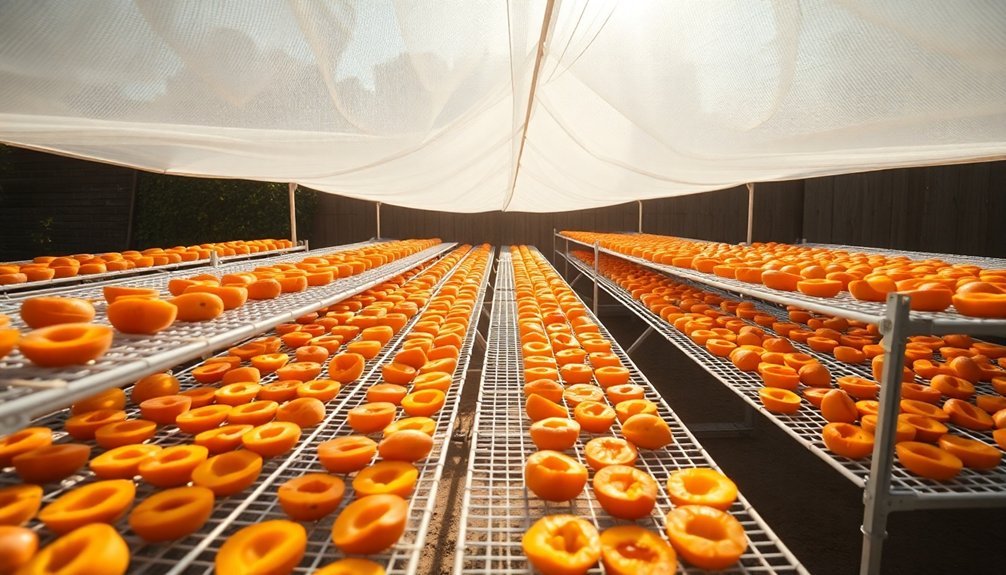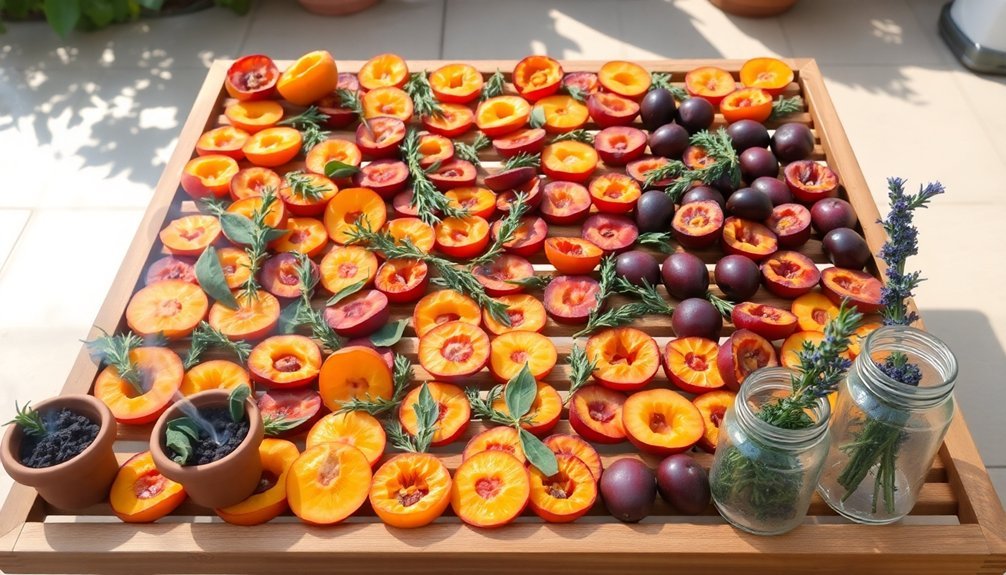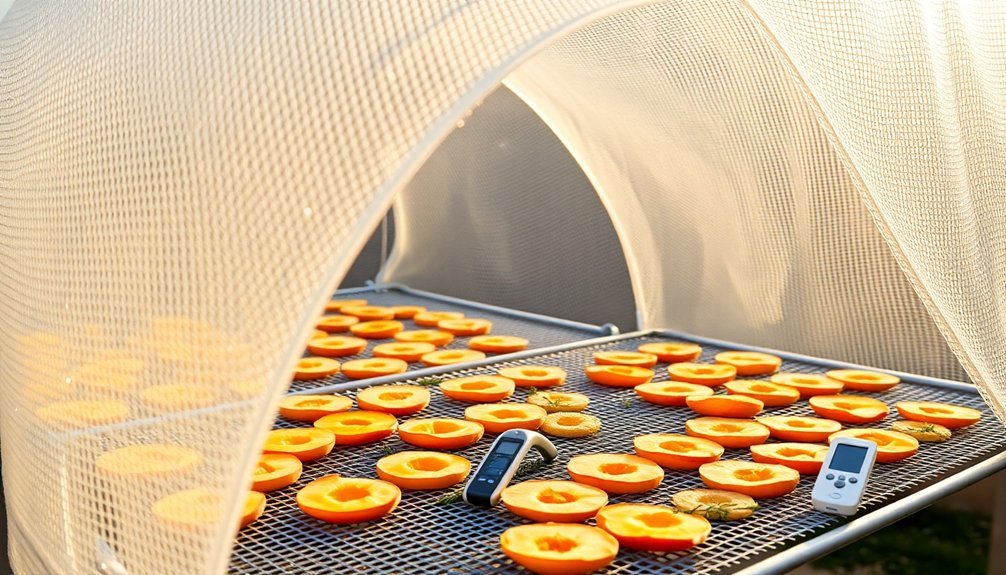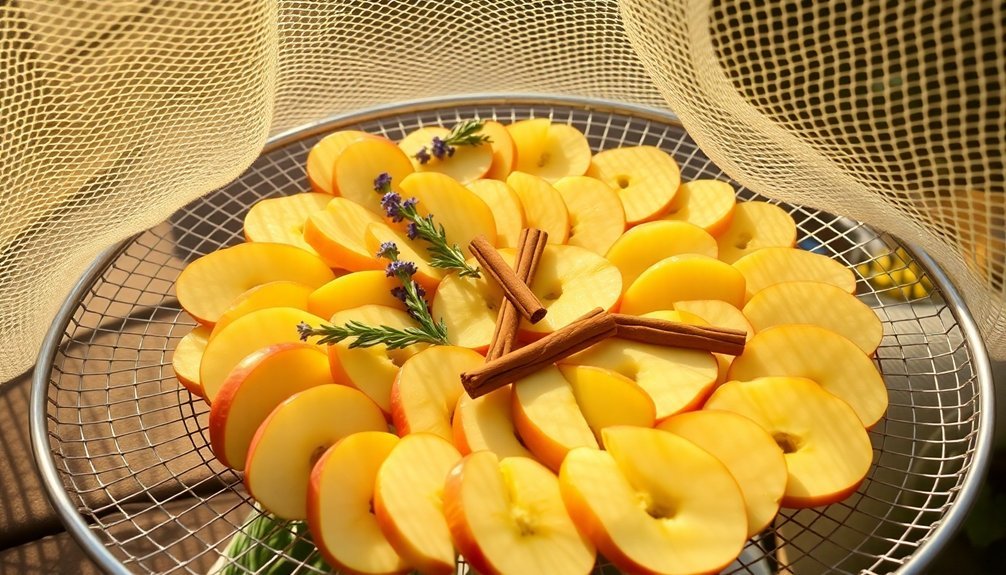You'll need multiple layers of protection to keep bugs away while sun-drying fruits. Start by covering your drying trays with food-safe screens or cheesecloth suspended above the fruit to create a protective barrier. Keep temperatures between 86-100°F and humidity below 60% to discourage insect activity. Place aromatic herbs like lavender and lemongrass around your drying area as natural deterrents. Elevate your drying racks on blocks to improve air circulation and prevent moisture buildup. For complete protection, consider a double-layer system using both screens and cheesecloth. These essential steps will open the door to successful, bug-free fruit drying.
Physical Protection Methods

A gardener's success in sun-drying fruits relies heavily on proper physical protection methods. You'll need to create multiple barriers between your drying fruits and unwanted insects while maintaining proper airflow and sun exposure.
Start by choosing the right tray material – stainless steel, Teflon-coated fiberglass, or food-safe plastic screens work best. Don't use hardware cloth, copper, or aluminum screens, as they can harm your food. Cover your fruits with cheesecloth or protective screening, making sure it's suspended above the food to prevent direct contact. Temperatures above 98° F are essential for effective drying and pest prevention.
Position your trays strategically by elevating them on blocks to improve air circulation and keep them away from ground moisture. You can place the table legs in water-filled cans to stop crawling insects from reaching your fruit.
To further protect your drying fruits, spray the trays with nonstick cooking spray to prevent sticking and make turning easier.
Remember to bring your trays under shelter at night to avoid moisture condensation. During the day, place them on reflective surfaces like concrete or aluminum sheets to enhance drying, but provide occasional shelter from direct sunlight to prevent scorching.
Temperature and Humidity Control
You'll find the ideal bug prevention when sun-drying fruits by maintaining temperatures between 85-100°F and humidity below 60%, as these conditions effectively discourage insect activity while promoting proper drying.
Your daily monitoring should include checking weather forecasts and adjusting drying locations to maintain these ideal conditions throughout the process.
Food dehydrators provide consistent temperature control as an alternative to outdoor drying.
When nighttime temperatures drop more than 20 degrees, you'll need to bring your fruits indoors to protect them from moisture buildup and potential insect problems.
Optimal Drying Temperature Range
Successful sun-drying of fruits depends heavily on maintaining temperatures between 86°F and 100°F throughout the process.
You'll need a minimum temperature of 86°F for effective drying, though higher temperatures up to 98°F can speed up the process considerably. The increased heat promotes faster moisture evaporation, which is essential for proper preservation.
To achieve these ideal temperatures, you'll want to position your drying trays strategically. Place them on elevated surfaces like blocks or stands, and consider using metal sheets or concrete driveways as they reflect sunlight and increase the surrounding temperature. Ensuring each fruit slice maintains a uniform thickness of 5-10mm helps achieve even drying across all pieces.
You can also enhance the drying efficiency by ensuring proper air circulation – position your trays to allow airflow both above and below the fruit.
During particularly hot days when temperatures exceed 100°F, you'll need to monitor your fruit closely to prevent overheating.
You can start the process in direct sunlight and then move the trays to a shaded area to complete the drying. This approach helps maintain the perfect temperature range while preventing potential damage from excessive heat exposure.
Humidity Impact on Insects
While heat plays an essential role in sun-drying fruits, humidity levels can make or break your efforts to keep insects at bay. High humidity creates an ideal environment for insect infestation and reproduction, potentially leading to increased feeding damage on your drying fruits.
You'll need to pay close attention to both temperature and humidity levels to protect your produce effectively.
When you're dealing with humidity levels above 90% combined with temperatures around 35°C, you're creating perfect conditions for insect activity. To prevent this, you'll want to maintain temperatures below 13°C if possible, as this stops insects from feeding and reproducing regardless of humidity levels.
If you can't control temperature precisely during sun-drying, focus on reducing humidity through proper air circulation.
You can enhance your insect control by using insect-proof packaging once your fruits are dried. Think about implementing controlled atmosphere storage with low oxygen levels, or if feasible, refrigerate below 5°C.
Regular monitoring of both temperature and humidity conditions is vital. If you're dealing with persistent insect problems, you might want to explore alternative methods like controlled heat treatments or freezing at -18°C for at least 48 hours.
Managing Daily Heat Cycles
Managing daily heat cycles during sun-drying requires careful attention to both temperature and humidity control. You'll need temperatures above 98°F (36°C) for effective moisture evaporation, but don't let your fruits get too hot too quickly, as this can cause case hardening.
Start with higher temperatures around 145°F (62°C), then reduce to 135-140°F (57-60°C) once surface moisture has evaporated.
To optimize the drying process, guarantee proper air circulation both above and below your fruits. You can use a solar dryer to enhance airflow and reduce drying times. The combination of temperature control and air movement will help carry away moisture more effectively while preventing moisture buildup.
Monitor your fruits throughout the day, adjusting their exposure as needed. You'll want to give them several days in direct sun until they're about two-thirds dry, then move them to the shade to complete the process.
Keep checking the texture – fruits like apples should become firm and leathery. Remember that drying times will vary based on your location, humidity levels, and the size of your fruit pieces. Regular monitoring helps you avoid both under-drying and over-drying your produce.
Natural Bug Deterrent Solutions

You'll find powerful natural deterrents in essential oils like lavender and thyme, which effectively keep insects away from your drying fruits.
Adding salt or citrus-based solutions, such as a lemon juice and water mixture, creates an unfavorable environment for bugs while helping prevent fruit discoloration.
For additional protection, you can surround your drying area with aromatic herbs that naturally repel insects, making your sun-drying process much smoother.
Essential Oils That Work
Natural essential oils offer powerful protection against insects while sun-drying fruits, with several proven options that effectively deter unwanted pests.
You'll find that lemongrass oil is particularly effective, repelling mosquitoes, flies, bees, and wasps with its strong citrusy aroma. Eucalyptus citriodora oil provides long-lasting protection due to its PMD content, while cedarwood oil's woody scent keeps mosquitoes and ants at bay.
To use these oils effectively, you'll need to create a spray solution by diluting them with water. Remember to shake the mixture well before each application and reapply hourly, especially in hot, humid conditions. You can spray this solution around your fruit-drying area, but avoid direct contact with the fruits themselves.
For enhanced protection, try combining different essential oils. A blend of cedarwood, catnip, and eucalyptus creates a synergistic effect that's more powerful than using single oils alone.
If you're setting up an outdoor drying station, consider using an aromatherapy diffuser nearby or placing oil-soaked cotton balls in strategic locations. Just make sure you're diluting all essential oils properly with carrier oils to prevent skin irritation when handling.
Salt And Citrus Methods
Simple salt and citrus methods provide mixed results when keeping insects away from sun-drying fruits. While salt doesn't effectively repel bugs during the drying process, citrus solutions can be more helpful when combined with other protective measures.
| Salt Methods | Citrus Methods |
|---|---|
| Sprinkle on fruit for flavor, not bug control | Mix 1 cup lemon juice with 4 cups water |
| Limited effectiveness as insect deterrent | Soak fruit to prevent browning |
| Mainly absorbs moisture | Cover treated fruit with cheesecloth |
| Not recommended for bug prevention | Guarantee good air circulation |
| Not widely used in sun-drying process | Combine with other protective methods |
You'll find that salt's primary function is more about flavor enhancement than pest control. It's not a reliable method for keeping insects away from your drying fruit. However, you can create an effective citrus solution by combining lemon juice with water. After soaking your fruit in this mixture, you'll need to cover it with cheesecloth for best protection. The lemon juice treatment serves a dual purpose – it prevents browning while creating a slightly acidic environment that's less attractive to some insects. Remember that proper air circulation is essential when using any citrus method.
Aromatic Herb Protection
While protecting sun-drying fruits from insects can be challenging, aromatic herbs offer an effective and chemical-free defense system. You'll find that strategically placing herb bundles around your drying area creates a natural barrier against unwanted pests.
Herbs like sage, mint, and basil release potent oils when crushed or burned, deterring various insects from approaching your fruits. You can create protective borders by planting mint in containers (since it's invasive) or basil around your drying area.
For immediate protection, crush fresh herb leaves and scatter them near your drying fruits. Alternatively, bundle dried herbs like sage and rosemary, then burn them to create bug-repelling smoke. If you're looking for a more concentrated solution, essential oils derived from these herbs work effectively.
Try using lavender oil to repel moths and flies, or eucalyptus oil for broader pest control. For maximum effectiveness, combine multiple herb varieties. You might pair citronella grass with basil, or sage with mint.
Remember that lemongrass and citronella can provide up to three hours of protection when properly applied, making them ideal for shorter drying sessions.
Smart Drying Rack Setup
Setting up a proper drying rack system forms the foundation of successful fruit sun-drying without bug interference.
You'll need screens made from stainless steel, Teflon-coated fiberglass, or plastic to guarantee durability and prevent unwanted residue. Make sure the mesh is tightly woven to block insects while allowing proper air circulation.
Elevate your drying racks using blocks, bricks, or books to create a barrier against crawling insects. Place them on a concrete driveway or over aluminum sheeting to reflect sunlight and increase drying temperature.
You'll want to maintain a gap between the ground and rack while guaranteeing the surface below stays dry.
Create a double-layer protection system by using two screens – one as a shelf and another as a cover. You can also add cheesecloth as an extra protective layer against birds and insects. Secure these covers tightly to prevent bugs from sneaking underneath.
Don't forget to spray the trays with nonstick cooking spray to prevent fruit from sticking.
Remember to bring your racks inside at night and regularly inspect them for signs of insect activity. Keep the surrounding area clean to minimize bug attraction.
Safe Pasteurization Steps

Pasteurizing sun-dried fruits properly guarantees your harvest stays bug-free and safe for consumption.
You'll need to choose between two effective methods: heat treatment or freezing. If you opt for the heat method, place your dried fruits in an oven at 175°F (80°C) for 10-15 minutes. For the freezer method, store your fruits at 0°F (-18°C) for 48 hours.
Don't skip this vital step, as pasteurization eliminates any remaining insects and their eggs that might've survived the drying process.
After heat-treating or freezing your fruits, let them return to room temperature before you package them. You'll want to use airtight, opaque containers that protect against moisture and light exposure.
When you're ready to store your pasteurized fruits, make sure to label each container with essential information: the type of fruit, any pretreatment steps you've taken, and the processing date.
Keep your containers in a cool, dry place away from direct light to maintain quality. Remember to avoid metal containers, as they can contaminate your dried fruits.
Essential Fruit Testing Guidelines
Before diving into sun-drying, testing your fruits for quality and safety guarantees the best possible end product. You'll need to evaluate several key factors to verify your fruits meet safety and quality standards.
Start by checking for contaminants using standardized sampling methods. Select at least 10 random fruits of each size that don't show visible damage from pests, diseases, or sun scorch. You'll want to test for pesticide residues and harmful microorganisms like E. coli and Salmonella, though this typically requires professional laboratory analysis.
For quality assessment, you can perform several tests yourself. Use a refractometer to measure sugar content (Brix value) and a pH meter to check acidity levels. Test the fruit's firmness with a penetrometer to determine proper ripeness.
Examine color consistency using visual inspection, as uneven coloring might indicate quality issues. Don't forget physical measurements. Use digital calipers to check size uniformity and a reliable scale for weight consistency.
These measurements help you sort fruits appropriately and predict drying times. Document all test results to maintain consistency in your sun-drying process and verify repeatable quality outcomes.
Frequently Asked Questions
How Long Can Dried Fruits Be Safely Stored After Using Bug Protection Methods?
You can store your protected dried fruits for 6-12 months in the pantry, 1-2 years in the fridge, or indefinitely in the freezer. Just keep them in airtight containers and check regularly for spoilage.
Can Essential Oils Be Used as Natural Insect Repellents During Drying?
Yes, you can effectively use essential oils while drying fruits. Try spraying diluted citronella, peppermint, or lemongrass around your drying area. Just don't apply oils directly to fruits to maintain food safety.
Do Different Colored Fruits Attract Different Types of Insects While Drying?
No, you won't find that fruit colors specifically attract different insects. Instead, they're drawn to ripeness, moisture, and fermentation. It's the condition of your fruit that matters most, not its color.
What Time of Day Is Best to Start the Sun-Drying Process?
You'll want to start sun-drying early in the morning when the sun's up. Choose hot, dry days above 85°F with low humidity. Remember to bring your fruit inside at night to avoid moisture.
Does Fruit Thickness Affect the Likelihood of Insect Infestation During Drying?
Yes, thicker fruits are more likely to attract insects during drying since they provide more space and nutrients for larval development. You'll find that thicker pieces take longer to dry, giving bugs more opportunity.
In Summary
Keep your sun-dried fruits bug-free by combining multiple protective measures. You'll need proper physical barriers like mesh screens or nets, ideal temperature control, and natural deterrents like bay leaves or neem. Set up your drying racks strategically, maintain cleanliness, and test fruit regularly for moisture content. When you follow these steps consistently, you'll produce safe, pest-free dried fruits every time.





Leave a Reply